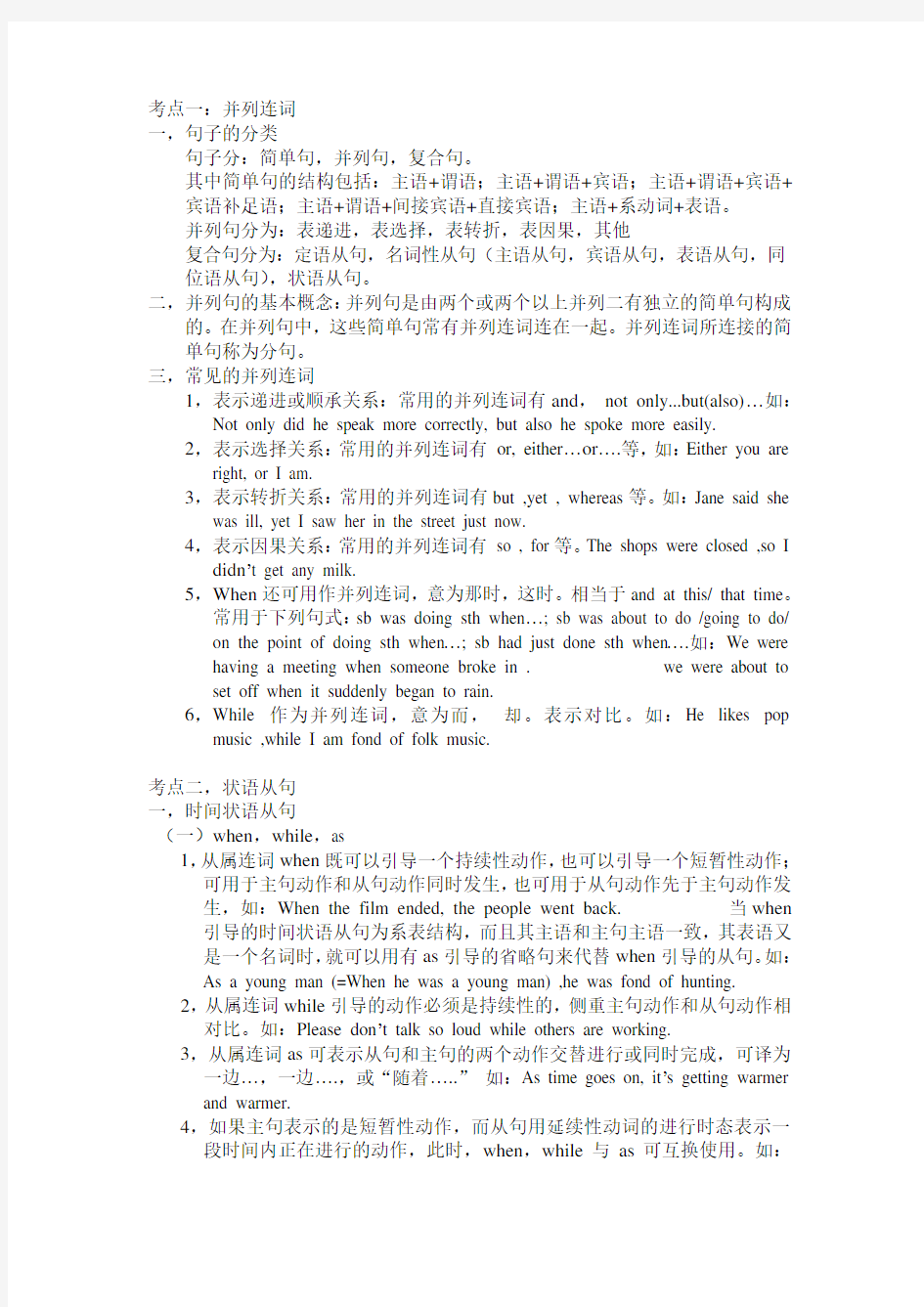并列连词和状语从句

- 1、下载文档前请自行甄别文档内容的完整性,平台不提供额外的编辑、内容补充、找答案等附加服务。
- 2、"仅部分预览"的文档,不可在线预览部分如存在完整性等问题,可反馈申请退款(可完整预览的文档不适用该条件!)。
- 3、如文档侵犯您的权益,请联系客服反馈,我们会尽快为您处理(人工客服工作时间:9:00-18:30)。
考点一:并列连词
一,句子的分类
句子分:简单句,并列句,复合句。
其中简单句的结构包括:主语+谓语;主语+谓语+宾语;主语+谓语+宾语+宾语补足语;主语+谓语+间接宾语+直接宾语;主语+系动词+表语。
并列句分为:表递进,表选择,表转折,表因果,其他
复合句分为:定语从句,名词性从句(主语从句,宾语从句,表语从句,同位语从句),状语从句。
二,并列句的基本概念:并列句是由两个或两个以上并列二有独立的简单句构成的。在并列句中,这些简单句常有并列连词连在一起。并列连词所连接的简单句称为分句。
三,常见的并列连词
1,表示递进或顺承关系:常用的并列连词有and,not only...but(also)…如:Not only did he speak more correctly, but also he spoke more easily.
2,表示选择关系:常用的并列连词有or, either…or….等,如:Either you are right, or I am.
3,表示转折关系:常用的并列连词有but ,yet , whereas等。如:Jane said she was ill, yet I saw her in the street just now.
4,表示因果关系:常用的并列连词有so , for等。The shops were closed ,so I didn’t get any milk.
5,When还可用作并列连词,意为那时,这时。相当于and at this/ that time。
常用于下列句式:sb was doing sth when…; sb was about to do /going to do/
on the point of doing sth when…; sb had just done sth when….如:We were
having a meeting when someone broke in . we were about to
set off when it suddenly began to rain.
6,While 作为并列连词,意为而,却。表示对比。如:He likes pop music ,while I am fond of folk music.
考点二,状语从句
一,时间状语从句
(一)when,while,as
1,从属连词when既可以引导一个持续性动作,也可以引导一个短暂性动作;
可用于主句动作和从句动作同时发生,也可用于从句动作先于主句动作发生,如:When the film ended, the people went back. 当when 引导的时间状语从句为系表结构,而且其主语和主句主语一致,其表语又是一个名词时,就可以用有as引导的省略句来代替when引导的从句。如:As a young man (=When he was a young man) ,he was fond of hunting.
2,从属连词while引导的动作必须是持续性的,侧重主句动作和从句动作相对比。如:Please don’t talk so loud while others are working.
3,从属连词as可表示从句和主句的两个动作交替进行或同时完成,可译为一边…,一边….,或“随着…..”如:As time goes on, it’s getting warmer and warmer.
4,如果主句表示的是短暂性动作,而从句用延续性动词的进行时态表示一段时间内正在进行的动作,此时,when,while与as可互换使用。如:
When/ While/ As I was walking down the street, I came across an old friend of mine.
(二),as soon as ,immediately, directly ,instantly ,the moment, the minute, the instant 和once(一…就…)。这些从属连词引导的从句都表示从句的动作一发生,主句的动作随即发生,常译为:一……就…..。如:The boy burst into tears immediately he saw his mother.
注意:no sooner ….than…; hardly/ scarcely…when…也可以表示“一….
就…”,这一结构的时态搭配为:no sooner与hardly/ scarcely所在的主句的谓语动词应用过去完成时,而than或when引导的从句的谓语动词应用一般过去时。此外,当把no sooner和hardly/ scarcely 提到句首时,其所在的主句应用倒装语序。如:
I had hardly got home when it began to rain
Hardly had I got home when it began to rain.
We had no sooner arrived at the station than the train left.
No sooner had we arrived at the station than the train left.
(三)till, until 和not…until
1,肯定句:主句的谓语动词必须时延续性动词,主句,从句都为肯定式,意为:某动作一致持续到某时间点才停止。如:He remained there until/ till she arrived. You may stay here until/ till the rain stops.
2,否定句:主句的谓语动词必须是非延续性动词,从句为肯定式,意为:某动作直到从句所述的时间点才开始,此前一直未开始。如:He won’t go to bed until/ till she returns.
3,till不可以置于句首,而until可以。如:Until you told me I had no idea of it.
4,not until….句型的强调和倒装用法。
如:直到你告诉我,我才知道这件事。
It was not until you told me that I had any idea of it.强调句
Not until you told me did I have any idea of it.(not until置于句首,主句部分要倒装)
(四),before和since
1,若表达“还未…就…;不到…就….; …..才…; 还没来得及….就…..”时,需用连词before。如:We had sailed four days and four nights before we saw land.
2,before从句中谓语不用够定时。如:Before they reached the station ,the had gone.
3,It will be /was +一段时间+before 常翻译为:……才, …..就。如:
It was half a year before I came back .半年后我才能回来
It won’t be long before we meet again. 过不了多久我们就有能见面了。
4,since从句的谓语动词一般是非延续性动词,主句的谓语动词是延续性的或者是反复发生过的动作。Since从句的时态若是一般过去时,主句的时态常是现在完成时或现在完成进行时。如:I have written home four times since I came here. She has been working in this factory since she left school.
